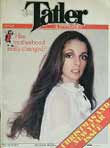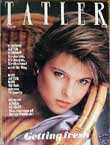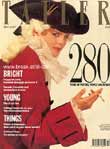Women's monthly magazines:
Scene to Zest
This page links to profiles of women's monthly magazines, known as glossies or slicks because of their high production values and upmarket editorial, often based on fashion and beauty. Some women's weeklies – such as Grazia and Riva - are included because of their attempts to become weekly glossies. There is an index page for women's monthlies. Also, magazines are arranged alphabetically on these pages:
- 19 to Cosmopolitan
- Easy Living to Grazia
- Harper's Bazaar to More!
- New Woman to Over 21
- Queen to Riva
- Scene to Zest [this page]
- Table of top 5 sellers
- Key facts on women's monthlies
Index to women's monthly magazines.
Women's magazine sales (1938-59).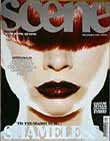 Scene – a glossy women's fashion monthly that was known for its use of photography |
SceneSpiro Group, fashion monthly, November 1997 – 2000Cutting-edge fashion photography under editor Deborah Bee became the trade mark for Scene, which had started out more as a catalogue. In October 1998, the Times quoted photographer David Bailey as saying it was second only to Italian Vogue: ‘For photography, Scene is the best magazine in England. You know it will use your pictures well, unlike the others, where complicated design has taken over.’A month later, the magazine used 70-year-old Daphne Selfe for a shoot. But soon after, Bee left to revive Nova for IPC and the title closed. |
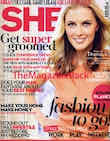 She – September 2011 cover – the last issue The first issue of She in March 1955 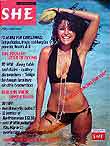 Large format version in November 1974 |
SheNational Magazine Company/Hearst, monthly, 1955-2011Must vie for the top spot when it comes to the most relaunched women's monthly magazine. Back in 1970 under editor Pamela Carmichael, it looked very different, being a large format title but only using colour for the cover and advertising. Known for extensive use of picture stories and witty captions. Printed by Sun Printers (Watford and London). In 1984, She was relaunched with slightly smaller pages and perfect binding rather than saddle stitching. Circulation rose slightly to 232,000. In 1989, She was considered to be Britain's most sexually
explicit women's magazine. It ran a regular feature, 'Love-making
Position of the Month' – complete with diagram. However, the
formula was not working and NatMags decided on a relaunch. Linda
Kelsey, editor of sister title Cosmopolitan, replaced Joyce
Hopkirk. The magazine became an 'emotionally based' magazine for
women aged 26-44 with children, rather than working women with no
children. Kelsey said that nothing would be left of the She
as it had been and that it would become 'a grown-up Cosmo'.
The radical re-positioning was seen as the start of a trend in consumer
publishing, with magazines trying to set themselves apart as being
distinctive and for a more tightly defined market. In 1990, £600,000
was spent advertising the relaunch on television. Also, a 16-page
sample issue was distributed to 500,000 households. Sales rose above
200,000 but peaked. In 1996, NatMags launched biennial Having
a Baby, which had been a banded-on supplements to She since
1994. ‘It's not a relaunch – it's a totally different magazine. I was drafted in a year ago to work on a launch codenamed "project Julie", and in April it was decided that She would go and the new magazine would take its name.’ The new version is aimed at ‘a younger 35-plus audience with modern lifestyles’. Line stood down from the title just six months after the relaunch in April 2006. Sales continued to fall and the last issue was dated September 2011. Hearst Magazines UK – formed in March that year when US parent Hearst bought Hachette Filipacchi from French media group Lagardere – closed She and Cosmopolitan Bride, following a strateegy review. She's circulation was 144,583 at the end of 2010National Magazines profile |
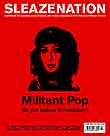 Sleazenation Che Guevara cover (February 2001) 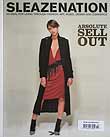 October 2001 Sleazenation cover was an attached lenticular sheet on which the words 'Absolute sell-out' changed colour as the cover was tilted 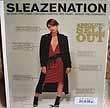
|
Sleazenation / SleazeSwinstead, London. Fashion / lifestyle monthly. 1996-2005Fashion and lifestyle magazine with Steve Beale as founding editor. Used slogans such as 'Now even more superficial', '100 pages of hype & lies' and 'Absolute sell-out'. The October 2001 issue (£3.20; 132pp; editor, Steve Slocombe) was sponsored by Absolut vodka. The front cover was an attached lenticular sheet on which the words 'Absolute sell-out' changed colour as the cover was tilted. Absolut had an 'animated' lenticular advert on back cover. Sleazenation relaunched in April 2004 as Sleaze (the same month that Emap closed The Face). The editor was Neil Boorman who ran the titles as 'a vaguely anti-corporate style magazine' – despite its level of advertising. However, the attempt failed and the title closed a few months later. Swinstead profileDer Spiegel lenticular cover NME lenticular cover |
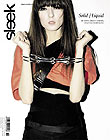 Sleek – the spring 2007 issue (above) is called solid/liquid, about 'chrome, chaps and champagne'. Cover is from a 22-page fashion photo shoot by Terry Richardson of model Irina Lazareanu, which starts by quoting lyrics from 'La Belle et la Bête' by Babyshambles |
SleekSleek Friends GmbH, Berlin. Quarterly. 2003- |
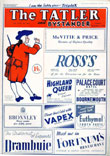 The Tatler & Bystander (1943 issue) – carried advertising on its cover into the 1950s (and 1970s) 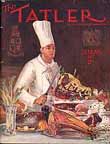 Christmas 1934 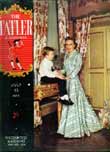 By 1955 Tatler & Bystander had changed its covers. Note the Tatler character 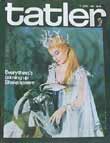 1965. The name Bystander is in the 'r' of the title, with the Tatler character below 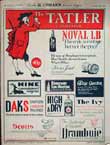 1968 relaunch with the old cover design. This is from 1975
|
TatlerTatler Publishing Co / Illustrated Newspapers / Thomson / Condé Nast, monthly, 3 July 1903 -The Tatler name dates back to 1709 when it was used by Addison and Steele, the founding fathers of English journalism, until 1711. However, the present-day society magazine only appeared in 1903 as a weekly. The cover carried advertising with a masthead and border featuring the Tatler character as a gentleman bowing in greeting. Like many magazines, it ran a special Christmas issue with an illustrated cover issue, a concept dating back to the Victorian era. Later, it was published by Illustrated Newspapers at 32-34 St Bride St, just off Fleet St, and printed by the Cornwall Press in Stamford St. A February 1936 issue with coverage of the funeral of King George V carried a black border to the cover. During the second world war, the Tatler absorbed Bystander magazine (published from 9 December 1903 to 30 October 1940) to become Tatler and Bystander. In the mid-1950s, the publishers redesigned the cover and started using photographs and illustrations. There were several redesigns in the next 10 years:
'The Tatler was widely regretted when it disappeared two years ago as there was no top class social magazine on a national scale left – the Tatler being the last and best of them. Now it is coming back in its proper form as a mirror of Society as it has always been since it was founded by Addison and Steele at the beginning of the 18th century. The group reverted to the cover style that Tatler had used in the first half of the 20th century. In 1979, the Australian millionaire Gary Bogard bought the title and appointed Tina Brown as editor. She boosted sales and in 1982, Condé Nast bought the title, bringing with it Brown. Tatler had a few turbulent months after Brown resigned in 1983 to concentrate on writing (but soon go on to Vanity Fair and later The New Yorker in the US). BBC Radio 4 presenter Libby Purves took over but only lasted a few weeks before cartoonist Mark Boxer ('Marc') – and former London Life editor – returned to the Tatler fold. He became editor-in-chief of both Vogue and Tatler but died in 1988 of cancer. The October 1989 issue claimed the heritage of the Tatler name by celebrating 280 years since a magazine with that title first came out. (The Spectator, established in 1828 claims to be the oldest continuously-published magazine in the English language; and in 1711, Steele and Addison also founded a newspaper called the Spectator.) Tatler has published regular supplements and spin-offs. Alongside the restaurant and travel guides, were Totler, for children (1995), and Bratler, for teenagers (1997). The latter listed 25 things its readers should have done by the age of 18, such as:
The essence of the title was summed up by Geordie Greig, who left his post as literary editor on the Sunday Times to take up the editorship in 1999:
The title regards itself today as a: Condé Nast profile |
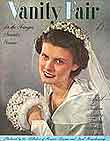 Vanity Fair – launched as a fashion title in November 1950 by National Magazines 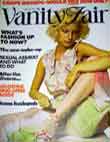 February 1972 (15p): one of the last issues under editor Audrey Slaughter carried a two-page advert for the forthcoming Cosmopolitan 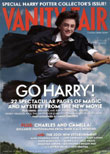 Vanity Fair – the Condé Nast version since 1990. For this October 2001 cover, the magazine sent photographer Annie Liebowitz to the Leavesden studios in Watford where the latest Harry Potter was then being filmed. Most of the magazine's covers are related to cinema |
Vanity Fair (UK)1868-1914; 1950-1972 (National Magazines); In November 1950, a new version based around fashion was launched by National Magazines (now Hearst UK), publishers of Harper's Bazaar and Good Housekeeping. It was for "the Younger Smarter Woman", with ready-made fashion that young women could afford rather than haute couture. NatMags puts the peak of its circulation at 238,000 copies in 1956, and it claimed to be 'Britain's largest circulating fashion magazine' in 1957. The magazine also ran a yearly competition, in association with Butlins, to find Miss Vanity Fair. By 1962 it was edited by Phyllis Bayley and published 18 times a year (monthly, but bimonthly in busy periods such as spring and autumn, a frequency that was common then). In June 1970, Audrey Slaughter, former editor of IPC's Honey and Petticoat magazines, was appointed editor to replace Hazel Evans. Brian Braithwaite was publisher. However, the magazine was in a weak position – the July 1970 issue ran to just 72 pages (26 of advertising) plus cover – and Slaughter was unable to turn it round. Meanwhile, the company decided to import Cosmopolitan from its US parent. That appeared in March 1972 and was an immediate success. The February issue of Vanity Fair (84 pages) featured a two-page advert for the the new magazine in the form of a questionnaire. Vanity Fair's circulation had fallen to about 93,000 and, just two months after Cosmo's launch, it was sold to IPC, who merged it with Honey. Slaughter took her staff and set up a company to launch Over 21 (‘Produced by the former staff of Vanity Fair’ said a cover flash on the first issue, with the cover date May 1972 ). The magazine's history in the US is just as chequered. It was founded in 1914 and in 1922 Vogue publisher Condé Nast bought Vanity Fair and House & Garden to form Condé Nast Publications. However, in 1936 he merged the title with Vogue. It was revived in 1983 in the US, at a cost of $7m. The March issue carried 168 pages of advertising worth $1.4m. However, the initial circulation near halved, as did advertising revenue. It became, in the words of The Washington Post,
Three editors had no success until Tina Brown arrived from Tatler in London (editor 1984-1992), since when it has not looked back (under E. Graydon Carter). By 1990, the magazine had a US circulation of 750,000 and it was decided to launch it in the UK with the same editorial as in the US and no editorial staff in the UK. Only the advertising (and hence the pagination) changed. (Although this was an unusual decision, it was not without precedent: Condé Nast had done the same with men's magazine Esquire in the 1950s.) Condé Nast claimed Vanity Fair – was already selling about 12,000 imported copies an issue without any promotion. Publisher Sally Vincent predicted sales of about 50,000 copies a month with a marketing budget of £1m. She expected the magazine to attract up-market adults with a median age of 30, about 40% of whom would be men. In 1990, Campaign reported that editor Tina Brown had justified choosing Cher rather than Maria Maples for the November cover so: ‘In light of the Gulf crisis, we thought a brunette was more appropriate.’ June 1991 saw a row between the Times and Vanity Fair. The magazine had reported the last words of Margaret Thatcher on resigning as prime minister as being that home was the place ‘you come to when you have nothing better to do’. The newspaper said this was a misquotation, a charge denied by Brown. By the end of the year, the magazine was claiming sales of 63,000. Tina Brown left in July 1992 to edit The New Yorker. She
was replaced by E. Graydon Carter, then editor of The New York
Observer and a founder of Spy. Brown had boosted circulation
with a series of editorial coups and controversial covers, such
as a naked, pregnant, Demi Moore (August 1991) and singer KD Laing
being shaved in a barber’s chair by model Cindy Crawford.
The American Society of Magazine Editors voted the Moore cover the
second best seen in the previous 40 years. In October 1992, Henry
Porter, former editor of the Sunday Correspondent Magazine was
appointed London editor with Francis Wheen as contributing editor.
The next year, British editorial was added in the form of four or
five pages of diary items, reviews, short stories and news. Condé
Nast concentrated on the top end of the market, with Vogue,
Tatler and Vanity Fair each aiming at specialist niches.
Vanity Fair showed Oasis singer Liam Gallagher with fiancee
Patsy Kensit on a 1997 cover under a Union Jack duvet for an article
rating London the hippest city in the world. It was seen as less
assured in 2005 when it had to pay out £50,000 in libel damages
plus costs to film maker Roman Polanski. |
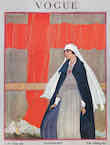 May 1918 issue of Vogue. At this time, the whole cover was an illustration 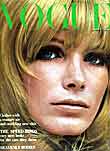 Norman Parkinson front cover for Vogue (15 October 1965). This issue was printed by Sun in Watford, ran to 164 pages and cost 3s. The editor was Beatrix Miller 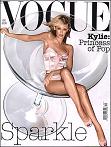 Vogue with Kylie Minogue on the front cover |
Vogue (UK)Condé Nast, monthly, 1916-Flagship magazine for Condé Nast in terms of longevity (founded 1892 in the US), advertising volume and reputation, if not total sales. British Vogue ("Brogue") was launched in 1916 whn the war made it impossible to carry on importing copies from the US. It had a virtual monopoly on style and fashion until Harper's Bazaar came along in 1929. In May 1996, watchmaker Omega withdrew its advertising from Vogue and complained that the 'skeletal appearance' of models in the magazine's fashion pages might help push girls into anorexia. Vogue is renowned as a style bible and is one of the most sought-after magazines by collectors because of its high quality editorial, photography and production values. In 2005, Vogue put up selection of covers on its website as part of a celebration of 10 years of Vogue.com. The faster pace
of the magazine market is demonstrated by fact that Vogue editors used to have 20-year-long tenures – Audrey Withers 1940-1960;
Beatrix Miller 1964-1986 – but the arrival of Anna Wintour in 1986
changed that. After Wintour went over to run US Vogue, Liz Tilberis took over 'Brogue' in 1989. She was followed
in 1992 by Alexandra Shulman, who was in the chair to celebrate Vogue's centenary in the uK in 2016. |
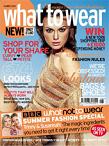 What to Wear – TV spin-off from the BBC |
What to WearBBC Worldwide, quarterly, Summer 2004-? Archived website for the What Not To Wear show |
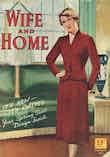 Wife and Home from February 1950 | Wife and Home [closed]Amalgamated Press, monthlyThe 'married woman's magazine'. Published at least from 1931 to 1955. The V&A holds a 'Leo the Lion and Tim the Tiger' pattern for two stuffed toys by 'Finella', Wife and Home's knitting expert in the 1940s. |
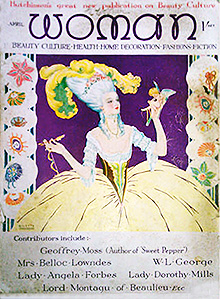 Hutchinson's Woman monthly magazine cover Aprily 1924 | Woman (Hutchinson's) [closed]Hutchinson, monthly, April 1924–?Woman was launched by Hutchinson's in 1924 and ran to at least two monthly issues. It focused on 'beauty culture' with other articles on health, home decoration, fashion and fiction. A flyer for the second issue bound into Britain Beautiful, a partwork from the same publishing house, stressed that is was 'superbly illustrated on art paper'. The inaugural issue had, apparently sold out and been reprinted twice. It was 'a wonderful shillingsworth'. Hutchinson drew several of the authors from the aristocracy, including Lady Ridley, Lady Dorothy Mills, Lady Angela Forbes, the Baroness Skornik and Lord Montagu of Beaulieu (founder of the classic car museum in Hampshire). Hilda Cowham drew the children's page. Not to be confused with Woman, the Odhams weekly published from 1937; or Woman's Magazine |
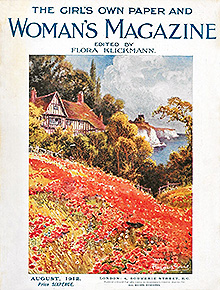 Girl's Own Paper and Woman's Magazine cover from August 1911. Flora Klickmann was the editor – and credited on the cover – for at least 20 years, from 1910 to 1930 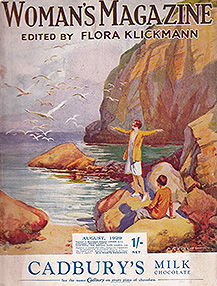 Woman's Magazine cover from 1929. The Girl's Own Paper element of the title was dropped in 1925 |
Woman's Magazine [closed]Lutterworth Periodicals, 4 Bouverie St, monthly, 1910–1951?Girl's Own Paper was a weekly for girls published from The Leisure Hour office from 1880 to 1908, when its name and coverage expanded as Woman's Magazine. The latter part of the name was made more prominent and it adopted a larger-than-A4 format. The two titles split apart in 1925. By 1930, the Girl's Own Paper had re-emerged as a monthly and took over Heiress in 1947, but closed three years later. Woman's Magazine downsized to a large A5 in the face of wartime paper rationing and never returned to a larger format. The name of Flora Klickmann, the Woman's Magazine editor, was prominently displayed with the cover masthead until 1930. Klickmann had succeeded Charles Peters as editor of the Girl's Own Paper and changed its approach. She was 41 at the time. In 1916, the Religious Tract Society published the first of her bucolic Flower-Patch books, based on her past articles and her home 'Rosemary Cottage', with its idyllic garden and views over the River Wye and Tintern Abbey. She would have been 63 when she stepped down from Woman's Magazine in 1930. She died in 1958. Not to be confused with Woman, the Odhams weekly published from 1937; or Hutchinson's short-lived Woman monthly in 1924 |
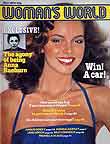 Woman's World cover from July 1979. The main cover line is: 'Exclusive. The agony of being Anna Raeburn' | Woman's World [closed]Carlton/IPC, monthly, 1978 – May 1990 |
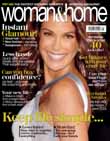 Woman & Home: sales still rising 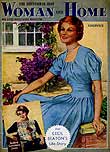 Woman & Home in September 1949 after it had taken over Good Needlework Woman & Home in September 1949 after it had taken over Good Needlework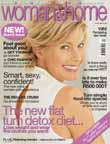 Woman & Home first issue in South Africa |
Woman & HomeAmalgamated Press / IPC Media / Time Inc UK, monthly, 1926 -Now aimed at 40-somethings, Woman & Home has succeeded in reinventing itself for generations of women. It is a fast-growing lifestyle title, epitomising a ‘brand new attitude’ for women over 35. Sales were up about 8% in 2005. For much of its life, an extra source of revenue was from dress patterns and transfers. The 1949 issue to the left (price 9d) featured a cottage-shaped tea cosy (pattern 1s 1d) , flower embroidery and back-to-school clothes in its centre four colour pages. The article featured on the cover was Cecil Beaton's life story. Apart from the centre pages, the only colour was on the cover with adverts for Dettol Ointment, Gloria shampoo and Bird's Custard. In 2005, IPC licensed Woman & Home to Caxton, South Africa's largest publisher. The launch editor was Frith Thomas.IPC/Time Inc UK profile |
 Working Woman
first issue with October 1984 cover date. BA manager
Jennifer Coutts Clay was the cover subject; Body Shop founder Anita
Roddick fronted the next edition Working Woman
first issue with October 1984 cover date. BA manager
Jennifer Coutts Clay was the cover subject; Body Shop founder Anita
Roddick fronted the next edition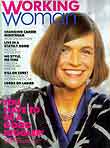 Redesign for September 1985, though still with a woman executive on the cover 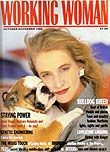 Working Woman last issue with Oct-Nov 1986 cover date |
Working Woman [closed]Wintour Publications / Preston Publications, monthly, October 1984 – Oct/Nov 86Audrey Slaughter was launch editor for this magazine aimed at women executives. It had financial backing from its US counterpart (Working Woman USA), ICFC, an anonymous donor and a consortium led by Ms Slaughter. Within a year, the masthead was redesigned, probably for better legibility on news-stands, and cover subjects were shown larger. In 1986, Marketing reported that Slaughter was concerned about the reluctance of advertisers to back the magazine. It was bought by millionaire Peter Cadbury under the name Preston Publications with a Fleet St address. However, Slaughter fell out with Cadbury over his plans to popularise the magazine and she left. Pandora Wodehouse was made editor in May. Sales were reported as about 30,000. The July and August issues were merged. The title was revamped with another masthead style; horoscopes were introduced; and it moved away from actual women as the cover subject. Despite the changes, publication of Working Woman was suspended in September with Cadbury blaming losses of £200,000 an issue. The last issue was dated October-November with Sue Reid as editor. Her letter to readers ended: 'A few people have suggested that this magazine would disappear altogether. We say, certainly not. I say, we're here to stay.' Slaughter also wrote a book, The Working Woman's Handbook: How to Organize Your Life, which was published by Century in May 1986. |
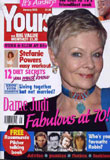 Yours – for women turned 50 with actress Dame Judi Dench on the cover |
YoursEmap Esprit, monthly, Autumn 1984- |
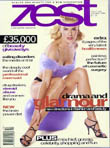 First issue of Cosmo spin-off Zest |
ZestNational Magazines/Hearst UK, monthly (since 1996), Autumn 1994-2014 |



